Some say a picture is worth a thousand words.
This blog includes both pictures and a chronological summary of my correspondence. The following photos are not from the internet; they are photos of how unit 409's doors, floors, walls and ceilings located below the site of the accident have looked for over 10 years, ever since the flood. By way of comparison, before the accident they were all fine.
The facts should speak for themselves with respect to showing the water damage to our building structure and fixtures, which
after years of continual requests, remains
unrepaired.
http://www.604fixdoor.com/
Photos 1, 2, & 3:
These photos show the water damage to our door systems
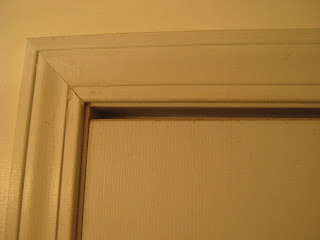
Crooked at the top - and at the bottom
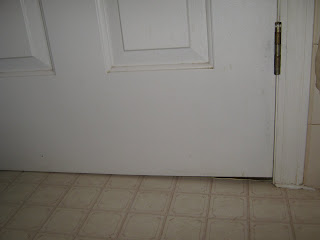
and warped sideways

In fact , after the flood our doors became so warped and crooked that they were no longer fit for the purpose for which they were intended. They stick or swing shut - or won't stay latched, locked, or closed - so locks are useless.
Photos 4 and 5:

Using the suitcase as a barrier to stop cat from pushing bedroom door open has created an awkward, unsightly tripping hazard.
Our interior door locks became useless after the flood warped the doors so badly that we could no longer rely on the doors to stay latched. We lost privacy protection - and have never since felt comfortable giving our neighbours a key to water our house plants while on vacation, or to provide access to contractors in our absence.
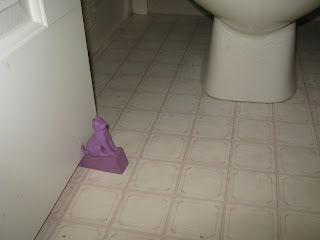
This door stopper has kept our bathroom door from swinging shut and blocking off access to our cat's litter box.
Photos 6, 7, and 8:
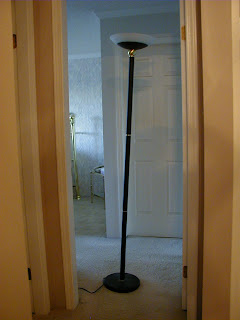
Since no council member visited our unit to inspect the damage - or walk on our sinking floors - and they continue to refuse to do so - the angle at which this lamp is standing in our bedroom helps illustrate how our floors warped and sunk in the area of the flood

including a distinct circular dip
directly above the shims for this supporting pillar in our garage below, which the developer's engineer thought was defective and made out some kind water soluble concrete

Phase 1 strata records from Sayers Engineering Limited dated January 19, 1989, advise that the concrete used in the columns in the lower unit’s garages appears to be the mix that is used for topping on the wood floor system in the upper units. We don't know if something in that concrete mix washed away, or if the shims shown in this photo shifted in the flood - but in any event - there is a distinctively circular dip in our floor where it is sinking directly above this column.
Photos 9 to 14:
409's hallway was so warped by the flood that the sliding doors had to be repositioned in order to close - after which the plastic wheel casings broke.
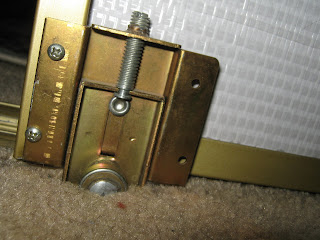
The hall wall split shortly after - at the top on the inside - and at the bottom on the outside.
When we painted before the flood we did not see any cracks or splits in our walls and our doors worked perfectly. We don't think our doors would warp, walls twist, drywall split, and strata managers start changing, all so suddenly, if no structural damage flowed from that flood.
This photo is of the crack at the top on the inside of our hall closet.

This photo is of the split at the bottom on the outside of our hall closet. To left of the spit the pencil marks made before and after the drying process can still be seen. Right above that are 5-inch high water marks.
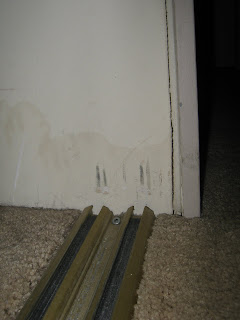
The original position of the track for the sliding doors was pencilled onto the wall by a restoration worker before he removed the doors, track, and carpets.
After moisture testing indicated that our walls were dry our carpets were relaid, and the track was reinstalled in line with those marks and the doors were rehung. The result was so crooked that the doors could not slide at all.
The worker took the doors off again, erased the marks, hung a plumb line, pencilled in new marks, and moved the track to match up to his new pencil marks. The faint residue of his original marks still showing where the doors hung previously, alongside the
unerased new marks that he pencilled in for the new position of the track, provides further evidence of the
unrepaired warping. The residual water marks can also been seen in this photo.
The vertical splits that developed in the wall soon afterward, which is visible to the right of the pencil marks.
When the wheel casings on the sliding doors in our hall closet broke
soon after the doors were removed, rehung (crooked), removed, and rehung
the door was just left lying on our floor;
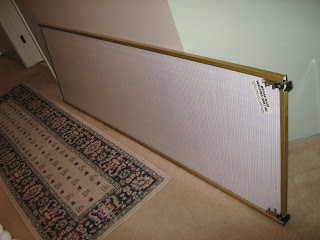
it's still not hung or working again
I complained about the seam between our main hallway and the living room and dining room being lumpy after the carpet was removed for drying and cleaning and then relaid. The horizontal shadow about halfway across the photo below is the line where the temporary bulge in that seam collapsed into a permanent indent. Although it didn't photograph very well this indented seam running across the entrance to our living room is in a high-profile central location. It is one of the first things seen by visitors entering our home. There's no reason for it to exist but for the problem I complained of after the flood, and I'd be surprised if the carpet in unit 227 was left in such a condition.
 This shows the wear pattern on our bedroom carpet from the warping
This shows the wear pattern on our bedroom carpet from the warping 
and how the finish on our vinyl flooring was spoiled from the drain cleaner that was applied in Unit 510 during their garburator floods.
Dirt collects in the area that was flooded and we can't clean it off. The finish was fine before Unit 510's garburator floods and even 10 years later in 2013 we still do not have this problem with the finish on any of our other vinyl floors. We do not wreck things.
The
unrepaired structural damage to our floors created indirect problems as well - it delayed replacement of 3 toilets that were in serious need of replacement as it seemed unreasonably wasteful to spend money to install new toilets when our floor coverings need replacement, and we were unable to install new flooring over a sinking
subfloor and damaged substrate. We still can't. We remain trapped in limbo waiting for repairs - year after year - with no end in sight as the strata continues shifting more and more of its responsibilities onto us. As we prepare for litigation as our very last resort the stress is particularly sickening.
These latches should be in the center for the plates, not the bottom.
Water stains remain in our ensuite doorway, 10 years after the flood
Repairs remain incomplete, damage is ongoing
Even the frames are splitting
Larry removed the locks when they became useless, thinking maybe the original hardware might latch, but it didn't.
The metal frame of our closet doors still shows rust
After putting our lives on hold for 10 years waiting for repairs, some damage has been covered up.
Watermarks 5-6 inches high in the bedroom across from the bathroom
and in the corner by the window, all of which I painted over after 10 years
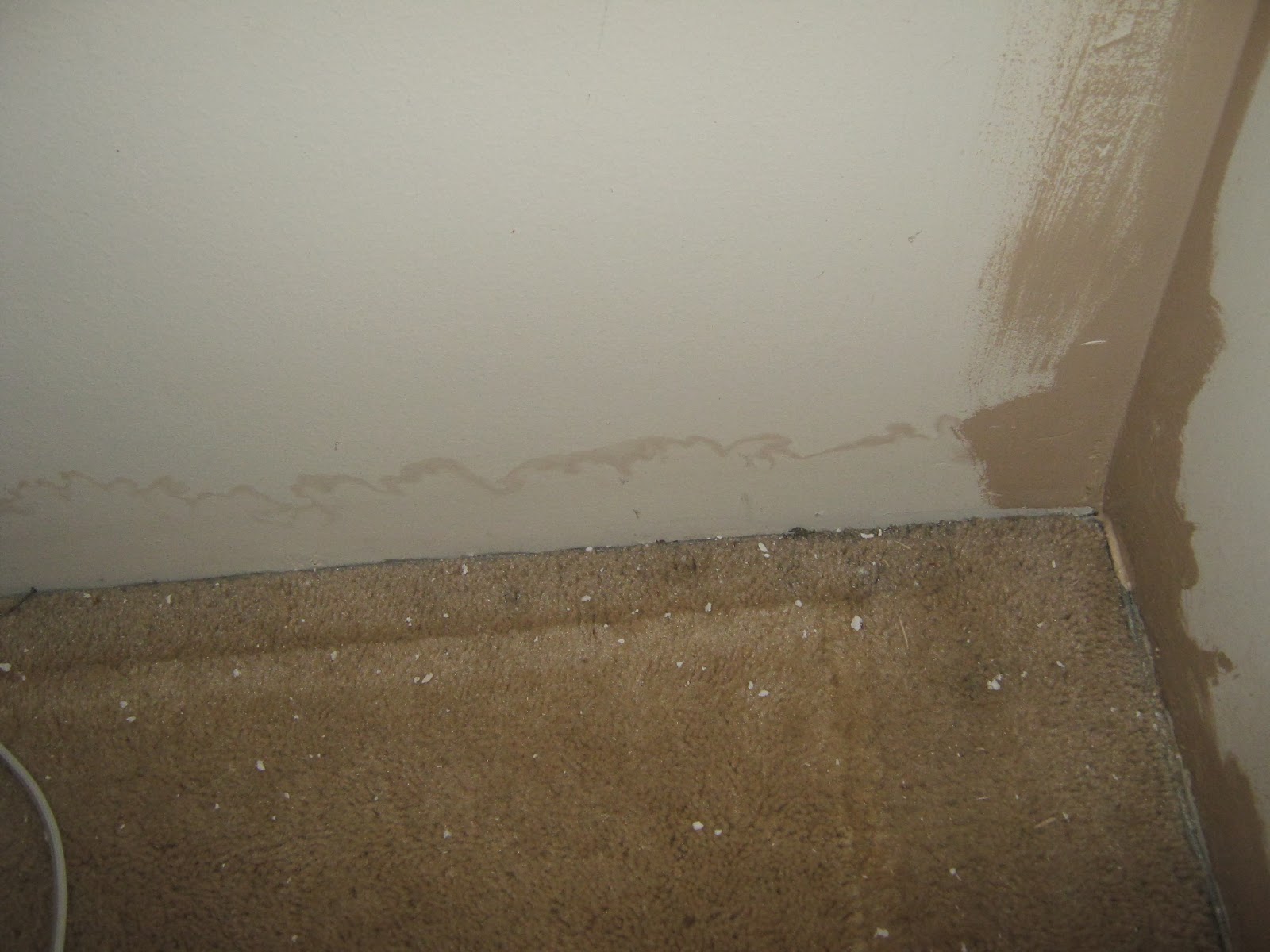
In spite of the strata corporation missing all of the limitation dates to file for remedies under insurance, tort, or contract; the strata corporation's duty to repair our strata lot is a constant and ongoing obligation that has no limitation date. The cracked walls, crooked floors, sinking ceilings, and warped doors from Unit 510's broken toilet tank, as well as the chronic mould from trespass into our ensuite shower by the developer are all an ongoing nuisance, to say the least.
These problems won't go away by themselves or get better with time.
My requests for a copy of the insurance cover were ignored and finally denied on the grounds of it being no longer in the records, at a time when said records were required by legislation to be kept and provided to us. We feel we were singled out, kept waiting, misled, and wrongfully deprived of insurance benefits that we paid for but could not claim directly, nor even obtain a copy of, leaving us with unrepaired water damage and years of grief.

The point of this blog is to motivate the strata corporation to
honour its ongoing obligation to
REPAIR OUR STRATA LOT TO THE SAME STANDARD AS OTHERS
We relied on strata legislation, our bylaws, our strata management,
and feel betrayed by all, including our neighbours. We are sick of it.
If owners are
NOT PROUD
of the facts set out in my strata blogs then
PLEASE VOTE
to remedy the situation - not to sue us for complaining about it
The balance of this blog relates to various damage to unit 409 flowing from water escaping from unit 510. There's nothing I'd like better than to be able to submit a more honourable report here - except to have no need to report at all.
****************************************************************
SO WHAT HAPPENED HERE?
My husband came home on July 23, 2003 and discovered unit 409 flooded from top to bottom -all through our ceiling, walls, carpets, floors, and the contents of our garage. The Crane toilet tank in unit 510 had burst right above us, but to this day we do not know how long the water was running - I was out of town visiting my mother in
Penticton, my husband was away also. Either nobody knew, or if they did know,
management certainly didn't seem to - not until we discovered the flood in our strata lot and reported it immediately as an emergency.
Within the next week or so another owner's Crane toilet tank burst in unit 227, which is a bottom unit. Accordingly, it was a somewhat lesser accident, one which occurred within their own unit and could not possibly damage their
mainfloor ceiling, walls, or doors, any other strata lot in a way that would compare to the water escaping into unit 510 and pouring all the way through unit 409 from the very top to bottom.
Strata management promptly and completely repaired the water damage to their strata lot at full replacement value and paid a $5,000 insurance deductible with no
chargeback to the owners of unit 227. Other than about $1600 poured into floor-leveling compound in unit 510, all I know is that there was no
chargeback to that unit either. The strata started repairs to our unit but took months playing around with superficial cover-ups and they are not completed, leaving us with warped doors, cracked walls, sinking floors, and damaged fixtures.
After over 10 years of endless distractions and delays and a report by the Strata's engineer that unrepaired damage in Unit 409 was consistent with water damage we had just enough work done to make sure that the locks on our doors stay latched to secure our privacy and free us up to take a trip before the end of 2013. We are seeking reimbursement from the strata of the $519.75 cost to us.
The door downstairs still sticks, and the bathroom door was not replaced, but it still cost over $500.
The major repairs are still outstanding.
We do not know with any certainty why all of this went so wrong - but we do know some things about damage to Unit 409 from Unit water escaping from Unit 510
- Unit 409 was repeatedly damaged by water escaping from unit 510 above during the years that Gloria Henderson and Dale McGee owned it. Water came pouring through the light fixture in the hall, which we caught in buckets (they said it was the roof, but it was pouring in too fast for that);
- Another time when we were flooded from 510 they told us the hose came off the washer;
- Time and time again we came home on holidays like Easter, Thanksgiving, and Christmas to find our sinks overflowed and the floor of our kitchen and family room a lake of filthy water filled with Henderson's garborator contents and something caustic like drain cleaner;
- Our floor coverings were easy to clean before their finish was destroyed in floods from 510
- Our floor coverings did not lift and bubble up before they were flooded from 510
- Plants grew below our patio until we poured the water from our kitchen floor over the railing;
- The soil seems to have been poisoned, very little, if anything, has grown in that area since then;
- We think that when we scooped the water into buckets and emptied them off over our railing it killed the plants below and poisoned the soil;
- The water pooled in a way that showed how warped and damaged the floor was;
- Our laser beam also shows it, but the strata persistently avoids testing with a laser to confirm it;
- Then Henderson's Crane toilet tank burst and flooded both units when Gloria Henderson was negotiating new insurance for the strata
- Nobody was home in either unit and the repairs to our unit took months just for the cosmetics
- We had no trouble with our doors prior to the flood; they always locked and stayed locked before the flood, but not since;
- The strata said the outstanding water damage would be repaired with the building envelope because it was "structural"
- The deductible in 2002 was $1,000 and in 2004 it was $5,000, but we could not obtain strata records that showed what the deductible was on July 23, 2003;
- The repairs the strata started and promised were inexplicably never completed;
- We were persistently, repeatedly, and permanently refused a requested copy of the insurance policy;
- We have reason to suspect that the strata was not insured on July 23, 2003;
- During the same period of time as all these floods the strata corporation accounting records show that Gloria Henderson was paid $825 by the strata corporation for do-it-yourself floor leveling - and that she submitted another invoice also for more than $800 for additional floor leveling compound for unit 510 - which brings the total cost for floor leveling on that one level unit to over $1,600. We don't know how much that is in today's dollars, but we think it is excessive and that the floor leveling compound in 510 is much thicker than it should be.
- Since this do-it-yourself project we started noticing the drywall panels in our ceiling showing. We hope that our ceiling does not collapse under all that extra weight.
Photos 15, 16, and 17

We are not construction experts - so we don't know if all that floor leveling compound in unit 510 results in a structurally viable "repair" - or if it creates a "hidden defect" - but, either way, we think the new floor covering looks as if it is very nice. So does the fireplace. (Since the chimneys are supposed to be somehow separated we don't know why, but after this gas fireplace conversion was installed upstairs we got more smoke downstairs whenever we tried to burn our fireplace - it is so toxic we haven't used our fireplace for about 10 years.)

It is not just the weight of excessive amount of floor leveling compound that is hazardous. With my lung disease I am also afraid of the health hazards.
Product Name: Rapid Set Topping Resurfacer Underlayment (TRU) Self-Leveling
Manufacturer Emergency Contact 1-714-379-8260
Chemical Family: Cementitious Mortar
Calcium Sulfoaluminate Cement, 960375-09-1, 30-60%
Crystalline Silica (Quartz), SiO2, 14808-60-7, 40-70%
HAZARDOUS INFORMATION
Inhalation Hazards: May cause respiratory tract, nose, throat, and lung irritation and inflammation
Chronic Exposure: Individuals may develop allergic dermatitis, inflammation of the cornea, and inflammation of the nose, throat, and lungs. May cause carcinogenic effects.
Threshold Limit Value: 5 mg/m3 (respirable dust), 10 mg/m3 (total dust), 30 million particles per cubic footHazardous Components, CAS No., PEL (OSHA)[mg/m3], TLV (ACGIH)[mg/m3]
Calcium Sulfoaluminate Cement, 960375-09-1, 15, 10
Crystalline Silica (Quartz), 14808-60-7, 10/(%SiO2+2), 0.05(respirable)
Our initial concerns about the effect of over $1600 in floor levelling compound spread over 1100 square feet in 2003 are now compounded by the discovery that for some reason the floor has been replaced again since then.
We don't know if more floor leveling compound was applied, but we do know that we have noticed new drywall damage and that our ceiling is now sinking. We strongly suspect that far more than the recommended maximum .5 inch depth of floor leveling compound is up there and wonder if the weight of it is what has been causing our ceiling to begin sinking at this late date.
This is the new damage to the wall above the door to the bedroom across from our main bathroom.
We don't know if it is the weight of all of that flooring compound, or settlement arising out of destroying trees for unobstructed panormanic views, or a defect that is legally required to be listed on a sales disclosure, but it is our understanding that until our ceiling is in immediate danger of collapse the strata engineer does not consider it to be a structural problem.
Even though it may not show up very well in pictures and we only notice it in certain lighting we are worried about the recent changes in our ceilings.
We are also unhappy about damage to our floors
from structural defects
geotechnical damage
floods from Unit 510's
garburator
and toilet
tank that burst in 2003

- We are not mathematicians - nevertheless with respect to insurance claims, we realize that water damage from a toilet tank bursting in an upper unit and flooding that upper unit's floors - as well as the lower unit's 2 levels of ceilings, walls, doors, and floors - would logically exceed any damage from a toilet tank bursting in a lower unit and flooding that one unit alone.
- Although the strata corporation insurance investigator did not attend our unit, we think it would be obvious that repairs of all the water damage to the 3 floors in units 510 and 409, as well as to unit 409's ceilings on 2 levels, and its still warped doors and walls, would have to exceed the $5,000 insurance deductible paid for the repairs to Unit 227 by itself.
- Unit 227 received prompt full replacement repairs for water damage that did not touch the floors and ceilings on at least one level of the building. Accordingly, it would on a balance of probabilities be less than the water damage to Unit 409 from the accident in 510; yet nearly 6 years after Unit 227 was fully repaired Unit 409 still has unrepaired water damage.
- The Strata Property Act says the strata must have insurance for replacement value repairs of water damage to our building and fixtures, and our bylaws say the strata is responsible to repair damage to the structure of our strata lot. There is NO WAY these repairs are our responsibility.
********
Requests for Repairs of Structural Defects
**************************************************************
Another structural problem is a misaligned air duct and wall of pipes, both hidden defects built by the developer, that cause a very serious nuisance.
The pipes between units 411 and 409 are trespassing on our property. The misaligned duct and plumbing wall encroach on space required for the proper function of Unit 409's ensuite - preventing use of the shower for approximately 20 years due to chronic problems with black mould/mildew.
.
This photos shows the vertical wall projection for the structural housing of the plumbing which intrudes 1.75" into our ensuite and correspondingly takes up the horizontal space which is essential to
accommodate the bath tub's ledge and transitions between the wall and tub that are required for a durable seal to minimize moisture intrusion and avoid mould.

That ledge would be showing below the tap in this picture if the plumbing was properly centered between the 2 units and positioned in our tub correctly. Instead of the ledge going all the way around our tub in the normal manner we have an intrusion creating abnormal mould.
When we replaced the
ensuite tiles and green backer board with new tiles and cement board we were surprised and disappointed to see the mould grow back again within a very few months. We repeatedly cleaned it out and re-sealed it, but the chronic mould just kept coming back, ending further use of that shower for decades.
This is not acceptable. It is not normal.
Bathtubs have a flange with a flat ledge
so tile can be installed with proper transitions between the wall and tub
without it the seal will fail.
The ledge on 409's ensuite flange is covered with a misaligned plumbing wall
so our seals keep failing and mould keeps growing.
What's worse, even though we have always run the fan for about an hour after our showers the fan in our ensuite can't draw air because the duct is so misaligned that it effectively reduces the opening for air to about half the intended size. There is nothing wrong with our fan, or our use of it, but the misaligned duct contributes to chronic mould growth. We have replaced the tiles and grout and repeatedly replaced the sealant, but this shower keeps growing mould
. And there is nothing we can do about it.
The s
hower in the main bath, which we have used nearly every day for 20 years, never grows mould. But for the chronic mould problem in 409's ensuite I probably would not sneeze the way I do, I think my lungs would last longer, I might live longer, I would feel better and most certainly be happier.
Unfortunately, it doesn't help to keep on replacing sealant
as long as the strata refuses to respond to our requests for structural repair of the overlapping venting and misaligned plumbing wall, and we are not authorized, or qualified, to repair the structure of the building ourselves.
Sections 68 and 69 of the Strata Property Act
govern the strata lot boundaries shown on the strata plan and provide implied easements
On Friday the 13 of December 2013 we were advised by the strata's Gary Langley of Hoot & Owl Maintenance and Repairs that we could chizel out the grout and replace it. We think that would be an expensive and very risk process, almost certain to break some tiles, but in any event, u
nless a judge determines otherwise, we are quite certain in the whole of the circumstances that the duty to repair damage arising out of a structural defect in the building is probably the strata's responsibility.
The fact that we have replaced and re-caulked the tiles and cleaned, dried, and re-caulked the perimeter of that bathtub more than once and the mould just keeps coming back when we use the shower, in comparison to the main bath that we have been showering in regularly for over 20 years without a problem, gives us strong reasons to believe the advice that we previously received from the Bathtub Guys that no matter what else is done the mould will come back due to the poor fit of the transitions between the fixtures and the wall arising out of the shared pipes being offset in a manner that causes the wall with the taps on it to protrude too far over our bathtub ledge for a proper seal.
The Bathtub Guys said the mold in our ensuite was higher than he had ever seen before, and the only way to avoid perpetual mold is to move the plumbing wall out of our tub and center it between units 409 and 411 so the plumbing is positioned equally in the tubs of the 2 units in the standard manner.
In this regard, section 68 of the Strata Property Act, governs the strata lot boundaries shown on the strata plan and section 69 provides the implied easements that are required to center the wall and eliminate the source of the mould problem.

This is a structural repair that must be done by the strata corporation, as it is impossible for such a thing to be done by an individual owner.
We would like this remedied, yet in spite of the strata's legal obligations to repair common property and structure in a strata lot, our complaints fall on deaf ears. Rather than inspect our strata lot or complete legally mandated repairs, strata management has left us to suffer for years with inescapable mold and lost use, while spending strata funds elsewhere on non-essentials and special interests.
We will wait until the next AGM for whatever remedy the strata selects, trusting that it will be effective, but that's it, we won't wait forever.
****************
We are tired of not just the delay and direct damage, but also the indirect nuisance.
We are tired of having to wait not only for strata repairs, but also to get on with our own projects and make use of our property. Before the flood we were planning to replace our carpets with laminate, but after the flood we couldn't proceed until the damaged substrate was repaired. It is unfair to put our lives on hold for 10 years while the strata delays completing the repairs that it started and promised and is responsible for.
We shut off the water to our toilet and waited years to install new low-flow toilets because we wanted to replace our bathroom floor coverings at the same time and in our opinion it was not efficient, nor practical for us to do so before the strata remedied the interrelated plumbing and structure of the common property between Unit 409 and Unit 411. We finally broke down and replaced our toilets after we gave up on our plans for laminate flooring when we got a dog
Meanwhile the only piece in our 4-piece
ensuite that we could use for years was our sink; mold still invades our shower; our tub's mechanical drain stopper is broken, the fan does not draw air, and the room is basically unfit for the purpose for which it is intended due to unrepaired damage that others are responsible for.
Instead of repairing the water damage and structure of the building of unit 409, the strata manager spent $5,885 to re-do Al MacLeod's fireplace in unit 518 on July 15, 2005. His couple of loose cracked tiles took priority over our years of mould and loss of use, without a report to the owners in the minutes, and without providing access to the correspondence.
In spite of not being in the minutes he recorded, decisions Mr. Mac made while on council which favoured his own self interest at the expense of others should never have been allowed, including the decision to abandon the landscaping and avoid reasonable user fees while exposing others to years of what the strata's lawyer called "horrific" risk.
This fireplace photo from the strata records is dated December 28, 2004. The dog decoration can be seen in other photos of unit 518, which I recognize from when I attended a meeting at Mr. Mac's. I found accounting records too - but no resolution in the minutes or anything anywhere else to reveal or justify paying $5,885 to Safeguard Mechancial Ltd. for repining firing of fireplace on July 15, 2005, and $139.10 for 518 - check fireplace on December 16, 2005.

In spite of my many requests for strata records much of the information shared in these blogs was repeatedly denied to me until finally one strata secretary gave me a copy of a CD, which contained among other things the photo records of Mr. Mac's fireplace which are published in my blogs.
Mr. Mac did not glue this loose tile back in place

or settle for less than full replacement of everything

The photos of Mr Mac's fireplace in the strata records

show a major re-do
WHO KNEW??
Where is the vote to authorize this spending decision? Was there a chargeback to anyone - or was this done at the expense of our little community of owners? When is there any record of this in the minutes? ?? Why are there such obvious divisions before the privileged "haves" and the under privileged "have nots" and so many undisclosed secrets in this little "community"?
Please forgive me for ranting but what - pray tell - gives Mr. MacLeod
's fireplace tile and other special interests, including illegally added extra decks and unobstructed views, destruction of landscaping and stockade style fencing priority over Unit 409's:
- warped doors
- sinking floors
- splitting walls
- broken sliders
- damaged floor coverings
- defectively installed plumbing, ceiling vent, exterior taps and cladding around our patio window.
Why do we have to live with loss of trees and geotechnical stability and a repeatedly sinking building?
Who voted to take away our patio space, address visibility, trees, and ground cover?
Who voted to downgrade the quality of our property?
It is difficult, if not impossible, to explain the difference in expenditures between a couple of tiles in Unit 518's strata lot and all of the unrepaired damage to Unit 409.
These tiles are broken in Unit 409.

We just live with them

Cracked tiles that look worse than Al MacLeod's
These tiles were installed by the developer, the same as all of the damaged floor coverings in Unit 409 - so we ask you - should the strata replace them? What about the defective ventilation? What about the defective plumbing?
Why are LAWS and health risks to me from mold and smoking fireplaces set aside by tiles on Mr. MacLeod's fireplace? Where did the strata funds for Al MacLeod's new fireplace and Mae Reid's new gate come from? Can anyone ANSWER that? Can the answers be seen by owners in the published minutes or financial statements? Can you show me when and where? Was it from special levy funds? contingency reserve funds? operating funds? insurance? a negotiated settlement? a damage award? Who can ANSWER that ... how can anyone ever tell? I have been asking for years without results.
Would a forensic accounting reveal the facts?
We would like to see if the strata has maintained insurance on the new items not installed by the developer, including the replacement windows and doors, and if so, under what terms. If replacing old bathroom pipes or defective toilets deprives owners of strata insurance that they are otherwise entitled to, it seems perverse. When an owner is making a change to items installed by the developer that are currently under the strata corporation's insurance policy it makes sense for the owner to insure the owner improvement portion that exceeds the original standard, not to offload the strata's responsibility for the whole thing. If a bylaw requiring owners to inform the strata when they buy new carpets would not be deemed an unreasonable invasion of privacy on the grounds of giving the strata the ability to maintain an inventory of those items they are no longer required to insure I would really like to see what the case law says.
The answer from the strata's depreciation report company, Norman Appraisals, to the question
Will suite improvements, such as flooring or cabinets, be included? is Yes, if they were installed and paid for by the building owner. In a situation where the building is older and most of the suites have undergone some replacement or modification, it is the appraiser's responsibility to determine a reasonable estimate of the overall type and quality of finish.
http://www.normac.ca/resources.php#7
Where is the moral compass of the Sunridge community? Personally, I try to conduct myself my a couple of simple rules. The first is not to do anything my family would not be proud to see published on the front page of the newspaper, or in today's terms, the world wide web. The second is to treat others as I would be treated myself, or even better.
We have paid fees to this strata corporation in more than our fair share for over 25 years and the benefits of those expenditures have been unfairly allocated to others. For complaining about corruption I have been deprived, threatened, falsely accused, defamed, and vilified by strata agents - particularly Al Macleod. - and the whole strata corporation has been paying a price for Mr. Macleod's punitive acts of retaliation. All I can do is try to survive and keep sending reports into what seems to be a surprisingly empty room.
Strata management failed to make the insurance claim or complete the corresponding repairs for water damage to our strata lot, leaving it as a "fixer-upper" surrounded by landscaping in a shambles and bursting pipes throughout the complex, and then called my requests for the insurance records, completion of repairs, and reinstatement of the landscaping and trees "harassment".
Another post in this blog outlines a 5-year chronological summary of events arising from the water damage to unit 409 from the toilet tank that burst in unit 510. Hopefully, readers will have the ability to determine for themselves what "harassment" is.
****
My reviews of the strata records reveal that the strata has spent our strata fees on extra decks, garage door openers, skylights, and other perks that are not allowed while failing to provide repairs and maintenance that are mandated by law.
PLEASE CLICK ON "OLDER POSTS" AND VOTE
We want the strata to comply with the law and:
- act fairly toward Unit 409
- complete repairs of the 2003 water damage to Unit 409 to a replacement value standard equal to the repairs in Unit 227
- repair the structure of Unit 409 to a standard equal to repairs to the structure of Unit 407, and
- center the plumbing to stop the 25-year trespass into our strata lot and allow use of our ensuite shower without causing mold.
****





































